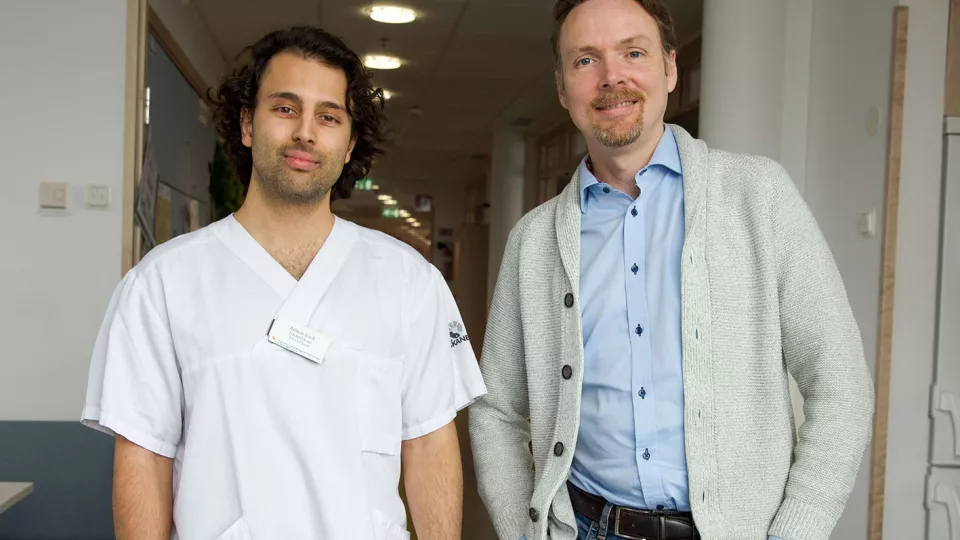Antibodies can be likened to keys, with antigens as the corresponding locks. Each antibody is uniquely shaped to fit a specific antigen, much like a key fits its particular lock. The precise ability to bind to disease-causing proteins makes antibodies invaluable for researchers developing new treatments.
In recent years, significant advancements have been made. For example, in healthcare, antibody treatments known as checkpoint inhibitors are drugs developed to help the immune system combat cancer. These antibodies block certain proteins, enhancing the body’s ability to fight specific cancers.
It took a supercomputer two months to see at the atomic level how the antibodies move in 3D
Pontus Nordenfelt and Arman Izadi are researchers at Lund University and more or less antibody designers. In the laboratory, they have developed antibodies targeting both SARS-CoV-2 and streptococcal bacteria, from patients infected with these diseases. Their goal is to understand what makes an antibody effective, enabling better protection for the body.
Genetically modified antibody
One of the most crucial and common types of antibodies is IgG, which exists in four variants. The stem (the pin on the Y) determines the antibody’s subgroup and signals the immune system upon encountering foreign substances. A study published in April 2024 in Nature Communications described a new hybrid antibody created by combining parts from two IgG subgroups.
"If you want to enhance the function of the antibodies, it is the stem that we can manipulate with genetic engineering, which we did. This has given us an antibody that does not naturally occur in the body," says Arman Izadi, a doctoral student in infectious medicine at Lund University, who during the study has worked as a doctor at Skåne University Hospital.
Stronger not always better?
Traditionally, it has been believed that the stronger an antibody binds to its antigen, the more effective it is.
"However, despite a 12-fold decrease in binding strength, we observed a fivefold improvement in the antibody's ability to activate the immune system to eliminate streptococcal bacteria," says Arman Izadi.
This finding raises the question: can a longer stem (called hinge) on the antibody enhance mobility and thus improve its signaling capacity to immune cells? One way to investigate this is to study the antibody at the atomic level, requiring the use of powerful supercomputers for complex calculations. The researchers collaborated with colleagues at the Pasteur Institute in France, where such a supercomputer is available.
"It took a supercomputer two months to see at the atomic level how the antibodies move in 3D in relation to the bacterium's antigen," says Pontus Nordenfelt, who leads the research group.
The best of two worlds
The supercomputer confirmed the lab’s observations: the newly designed IgG antibody does not bind as tightly but exhibits improved functionality. The antibody with a longer stem was significantly more mobile than the one with the stronger binding.
"We then tested our hypothesis by using genetic engineering to extend the original IgG1 subgroup to the stem of IgG3 in varying lengths. The second longest hybrid version demonstrated the best functionality and showed strong antigen binding," says Arman Izadi.
The researchers have examined the antibody in mice.
"You have to bear in mind that the animal model we use doesn't necessarily mean that it works in humans. However, when we test the hybrid antibody's ability in relation to the other two antibodies, only the hybrid antibody can protect the mice from disease. We get the best of both worlds, both good binding and good immune function that leads to a protective effect," says Pontus Nordenfelt.
Are we too fixated on binding?
This paradoxical result–that a weaker bond between antibody and antigen can lead to improved function–prompted the researchers to reconsider their focus. Is the research community overly fixated on binding strength?
"Perhaps we should prioritize antibody functions, even though this complicates research. Typically, binding strength is the primary focus, but we risk overlooking many potentially effective antibodies if we dismiss them solely due to weaker binding," says Pontus Nordenfelt.
